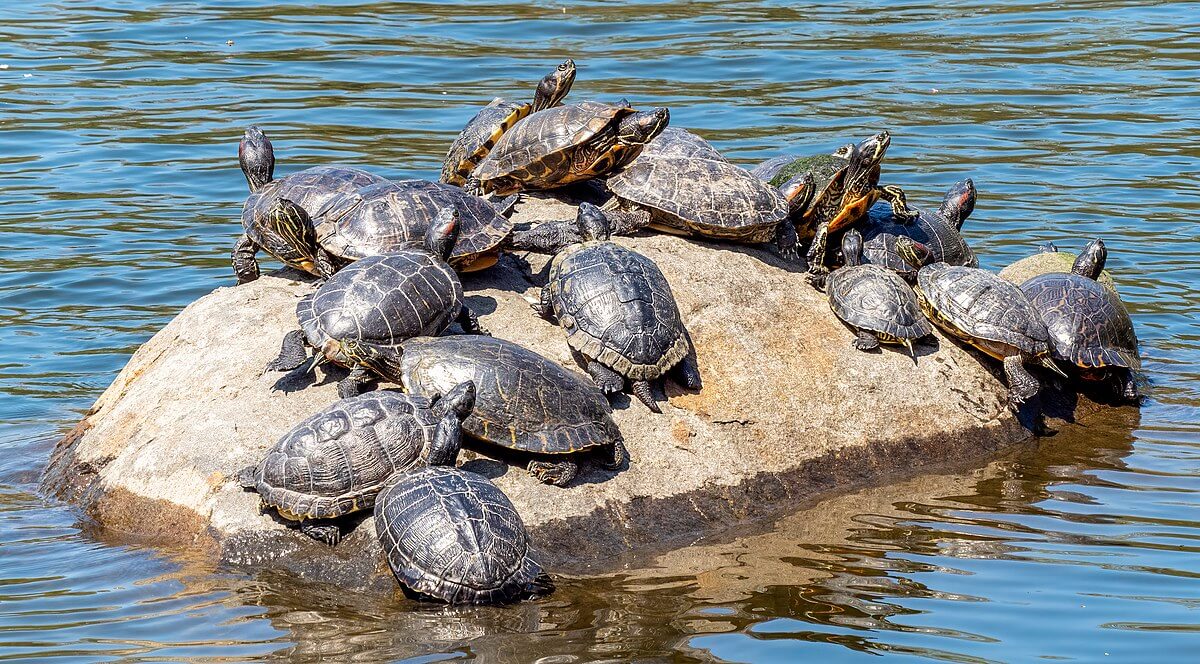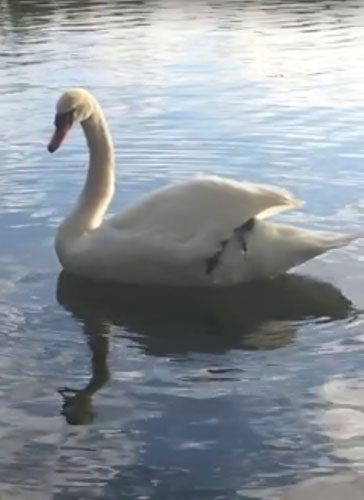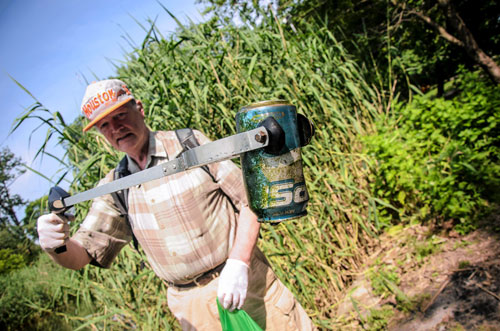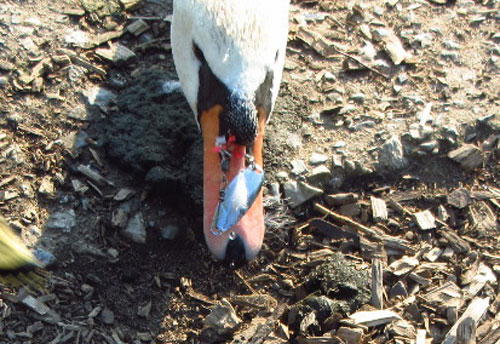Regular visitors to Prospect Park are well familiar with the population of turtles that roam the lake of Brooklyn’s Backyard — but few are familiar with the somber story of how the shell creatures came to be so populous in the park.
The bulk of the park’s turtle population consists of red-eared sliders — a little critter about the size of a dinner plate, and so-named for the shock of red along the side of their heads amidst an otherwise greenish body.
Scores of them live in Prospect Park, and they typically spend their days sunning on partially submerged rocks, swimming in the lake, and, for the most part, going about their business underneath the murky water.
But the dispriting truth is that those turtles are either abandoned pets, or the descendants of abandoned pets.
Red-eared sliders are not native to the New York metropolitan area, nor to the northeastern United States. Rather, their natural habitat is mainly in the south, especially the Mississippi River Delta. By Mother Nature’s natural edict, those critters should not be in Prospect Park.
But red-eared sliders are the most common turtles kept as pets in the United States, and the most commonly traded pet turtles in the world. They are often adopted as hatchlings, which is technically illegal, as New York law prohibits the sale of turtles under 4 inches, a move adopted in the 1950s to prevent salmonella outbreaks caused by children putting turtles in their mouth or kissing them, says Lorri Cramer of the New York Turtle and Tortoise Society.
Nonetheless, they can often be found being sold at fairs or in unregulated pet shops.
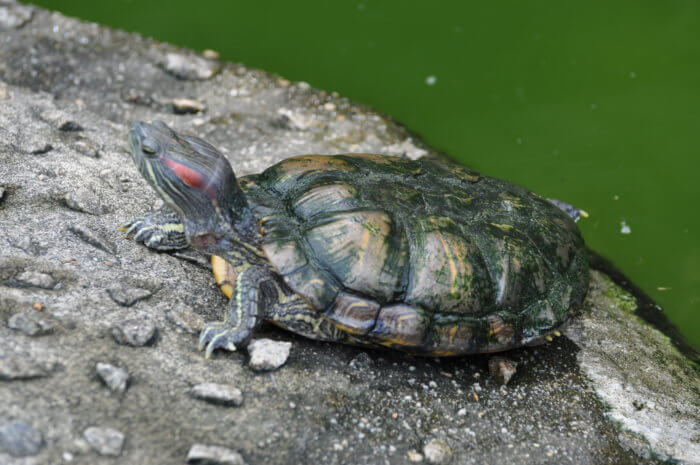
Unfortunately, some people who adopt them don’t know what they’re getting into, and are simply not ready to take care of the shelled beasts, whose average lifespan is typically 20-to-30 years, but often longer, and who grow to be much larger than they were as babies, requiring a bigger habitat and more food.
So, every year, dozens of people bring their pet turtles to Prospect Park and unceremoniously dump them in the lake or elsewhere in the park, Cramer says, figuring it would make sense to release it to live with its kind.
The Parks Department, however, warns against the practice, and points out that doing so is illegal.
“Prospect Park may feel like a home away from home, but it’s not an appropriate permanent residence for discarded pets — in fact, it’s against the law to dump animals in parks,” says Parks Department spokesperson Anessa Hodgson. “The red-eared sliders that are found in the pond have likely been introduced by pet owners who could no longer care for them.”
Cramer says that the abandoned sliders often cannot survive on their own in the park — they are not capable of feeding themselves, having been fed by humans their whole life. They are also not acquainted with wild turtles’ cycle of brumation, a kind of light hibernation that many reptiles partake in over the winter.
At the park, turtles brumate under the water, often burrowing holes into the muddy bed at the lake bottom.
“The turtles don’t know how to find their own food, they don’t go into hibernation at the right time,” Cramer said. “Many of them don’t make it through the winter.”
The ones that do survive wreak havoc on the park’s delicate ecosystem.
Red-eared sliders are listed by the Global Invasive Species Database as one of the 100 most harmful invasive species on the planet. They are often larger, faster, smarter, more aggressive, and more adaptable than the turtles already living in a given area, allowing them to outcompete the slower and smaller native species, such as painted turtles, which once were plentiful in city parks but have been largely replaced by sliders, along with yellow-bellied sliders and musk turtles. Red-eared sliders also are less wary of humans than many other species of turtles.
“They’re faster, they’re pretty smart, and they push out the turtles that normally might live there,” Cramer said. “The only ones that they don’t push out are the snapping turtles, which are much bigger.”
Those that lived as pets can also develop diseases in captivity that are unfamiliar to wild turtle species, infecting them with a potentially deadly condition.
And, as more and more sliders have been dumped in the lake over the years, they do what all animals do and reproduce, creating a surging population within the park. The Invasive Species Initiative notes that they reach sexual maturity at a young age and are highly fecund; in 2019, the Prospect Park Alliance sent out an alert asking parkgoers to leave turtles alone if they saw them away from the lake, as they were en route to nest and lay eggs.
But for the most part, experts say, the turtles in the park consist of those that have been dumped, as the land around the lake in urban parks is typically not suitable for a turtle to lay eggs, though that’s less the case in Prospect than in others.
Because so many people dump their pets, sliders have taken over bodies of water in parks all over the city.
“Every pond in New York City, especially in the parks, has a thriving population of red eared sliders that are kicking out native turtles,” said Allen Salzberg, publisher of the HerpDigest newsletter and a fellow member of the Turtle and Tortoise Society.
The phenomenon is not limited to New York or even the United States, as the turtles have been traded as pets all across the world, and their proliferation has become an issue as far away as Thailand. Salzberg says they are what’s known as “subsidized invasives,” species that would normally not be able to survive in the area, but nonetheless have a thriving population because of abandonment.
“The population still thrives because people keep throwing their ex-pet turtles in there,” Salzberg said. “And you can still buy them, even though it’s illegal.”
Cramer says that those interested in getting a pet turtle should consider adopting an adult.
“It would make a lot more sense for them to get a turtle that was full size,” she says. “They would know how big it is, how much room they need for it, and it would stop more tiny little turtles from being abandoned later on as they grow. It’s very painful, some of the calls I get are really sad.”
They should also call organizations like the Turtle and Tortoise Society if they are interested in adopting a slider, rather than buying one from a sketchy dealer, Cramer says. While the Society no longer has a formal adoption program, they are able to facilitate adoptions for those who request one. They can also help re-home a turtle that an owner can no longer care for.
The absolute last thing an overwhelmed pet owner should do, she says, is dump it in the park.
“They’re wonderful turtles, I had one for 40 years,” Cramer says. “To let them go, people are not doing their pets a favor. They’re killing them.”


